Detailed Analysis of Longwall Mining Operation Methods and Parameters
VerifiedAdded on 2020/03/01
|11
|2348
|101
Report
AI Summary
This report provides a comprehensive analysis of longwall mining operations. It begins by discussing various mining methods, including Single Pass Longwall, Multi-Slice Longwall, and Longwall Top Coal Caving, emphasizing their applications based on seam thickness and economic considerations. The report then delves into the critical aspects of pillar sizes, highlighting factors such as coal strength, roof conditions, and time-dependent strain, while underscoring the importance of pillars for worker safety. Furthermore, the report explores the significance of panel width during mining, its influence on production unit indices, and the best sequence of mining, comparing retreat and advance longwall methods. Part B of the report provides detailed calculations using Simpson's rule to determine coal volume and percentage recovery for different panel widths, incorporating parameters like pit pillar dimensions, seam thickness, and gate development. The analysis concludes by comparing the coal recovery percentages for different panel widths, offering insights into the impact of panel size on mining efficiency and pillar dimensions. The report references various sources to support its findings.
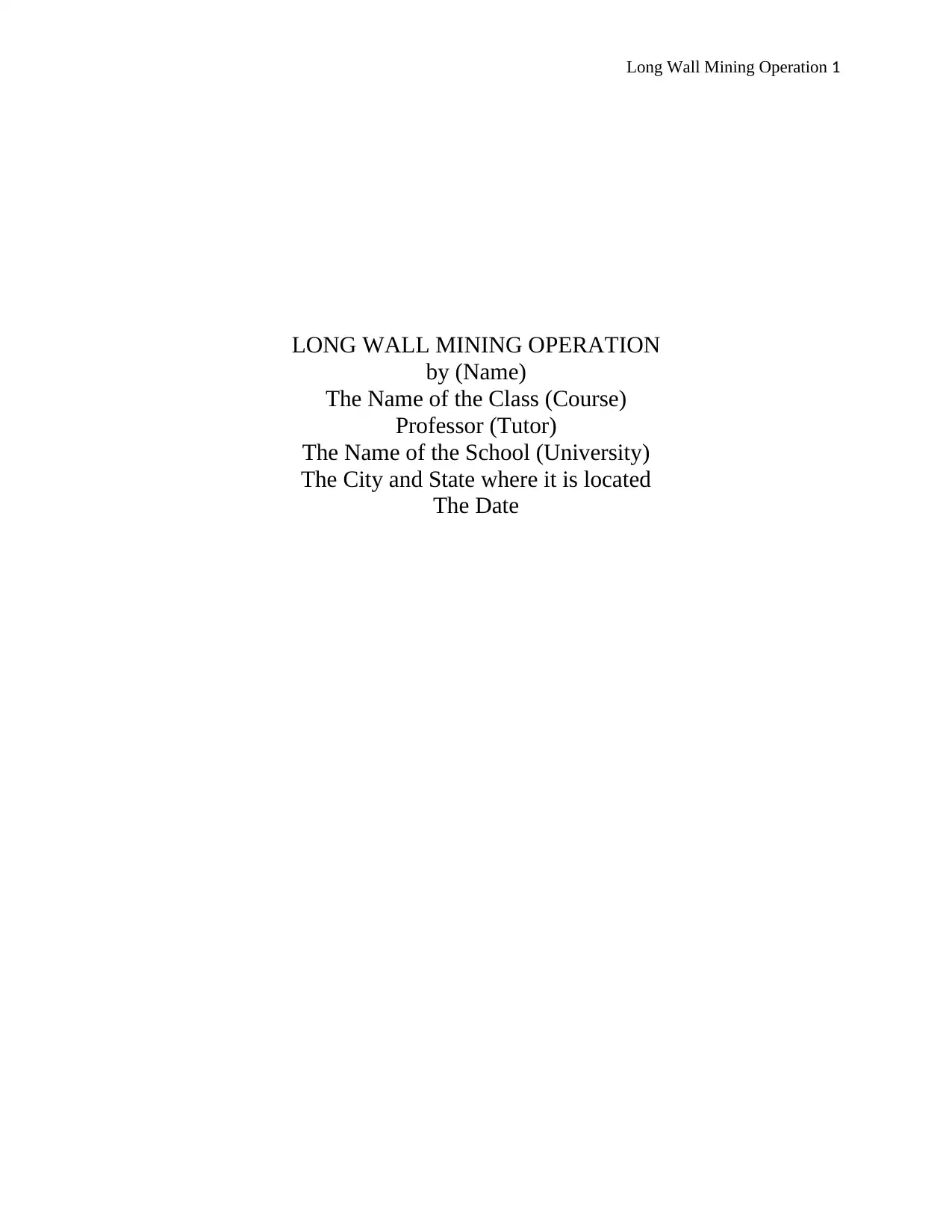
Long Wall Mining Operation 1
LONG WALL MINING OPERATION
by (Name)
The Name of the Class (Course)
Professor (Tutor)
The Name of the School (University)
The City and State where it is located
The Date
LONG WALL MINING OPERATION
by (Name)
The Name of the Class (Course)
Professor (Tutor)
The Name of the School (University)
The City and State where it is located
The Date
Paraphrase This Document
Need a fresh take? Get an instant paraphrase of this document with our AI Paraphraser
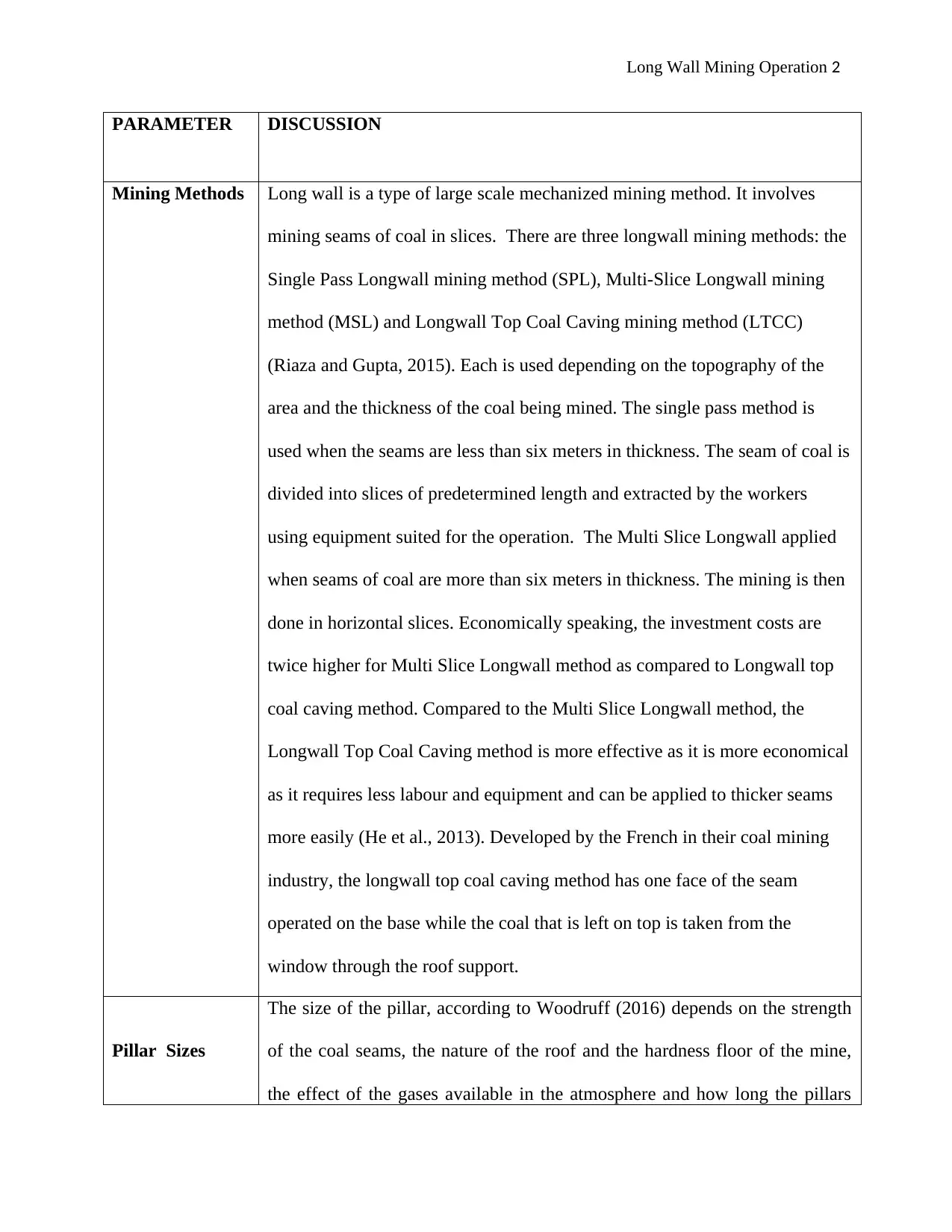
Long Wall Mining Operation 2
PARAMETER DISCUSSION
Mining Methods Long wall is a type of large scale mechanized mining method. It involves
mining seams of coal in slices. There are three longwall mining methods: the
Single Pass Longwall mining method (SPL), Multi-Slice Longwall mining
method (MSL) and Longwall Top Coal Caving mining method (LTCC)
(Riaza and Gupta, 2015). Each is used depending on the topography of the
area and the thickness of the coal being mined. The single pass method is
used when the seams are less than six meters in thickness. The seam of coal is
divided into slices of predetermined length and extracted by the workers
using equipment suited for the operation. The Multi Slice Longwall applied
when seams of coal are more than six meters in thickness. The mining is then
done in horizontal slices. Economically speaking, the investment costs are
twice higher for Multi Slice Longwall method as compared to Longwall top
coal caving method. Compared to the Multi Slice Longwall method, the
Longwall Top Coal Caving method is more effective as it is more economical
as it requires less labour and equipment and can be applied to thicker seams
more easily (He et al., 2013). Developed by the French in their coal mining
industry, the longwall top coal caving method has one face of the seam
operated on the base while the coal that is left on top is taken from the
window through the roof support.
Pillar Sizes
The size of the pillar, according to Woodruff (2016) depends on the strength
of the coal seams, the nature of the roof and the hardness floor of the mine,
the effect of the gases available in the atmosphere and how long the pillars
PARAMETER DISCUSSION
Mining Methods Long wall is a type of large scale mechanized mining method. It involves
mining seams of coal in slices. There are three longwall mining methods: the
Single Pass Longwall mining method (SPL), Multi-Slice Longwall mining
method (MSL) and Longwall Top Coal Caving mining method (LTCC)
(Riaza and Gupta, 2015). Each is used depending on the topography of the
area and the thickness of the coal being mined. The single pass method is
used when the seams are less than six meters in thickness. The seam of coal is
divided into slices of predetermined length and extracted by the workers
using equipment suited for the operation. The Multi Slice Longwall applied
when seams of coal are more than six meters in thickness. The mining is then
done in horizontal slices. Economically speaking, the investment costs are
twice higher for Multi Slice Longwall method as compared to Longwall top
coal caving method. Compared to the Multi Slice Longwall method, the
Longwall Top Coal Caving method is more effective as it is more economical
as it requires less labour and equipment and can be applied to thicker seams
more easily (He et al., 2013). Developed by the French in their coal mining
industry, the longwall top coal caving method has one face of the seam
operated on the base while the coal that is left on top is taken from the
window through the roof support.
Pillar Sizes
The size of the pillar, according to Woodruff (2016) depends on the strength
of the coal seams, the nature of the roof and the hardness floor of the mine,
the effect of the gases available in the atmosphere and how long the pillars
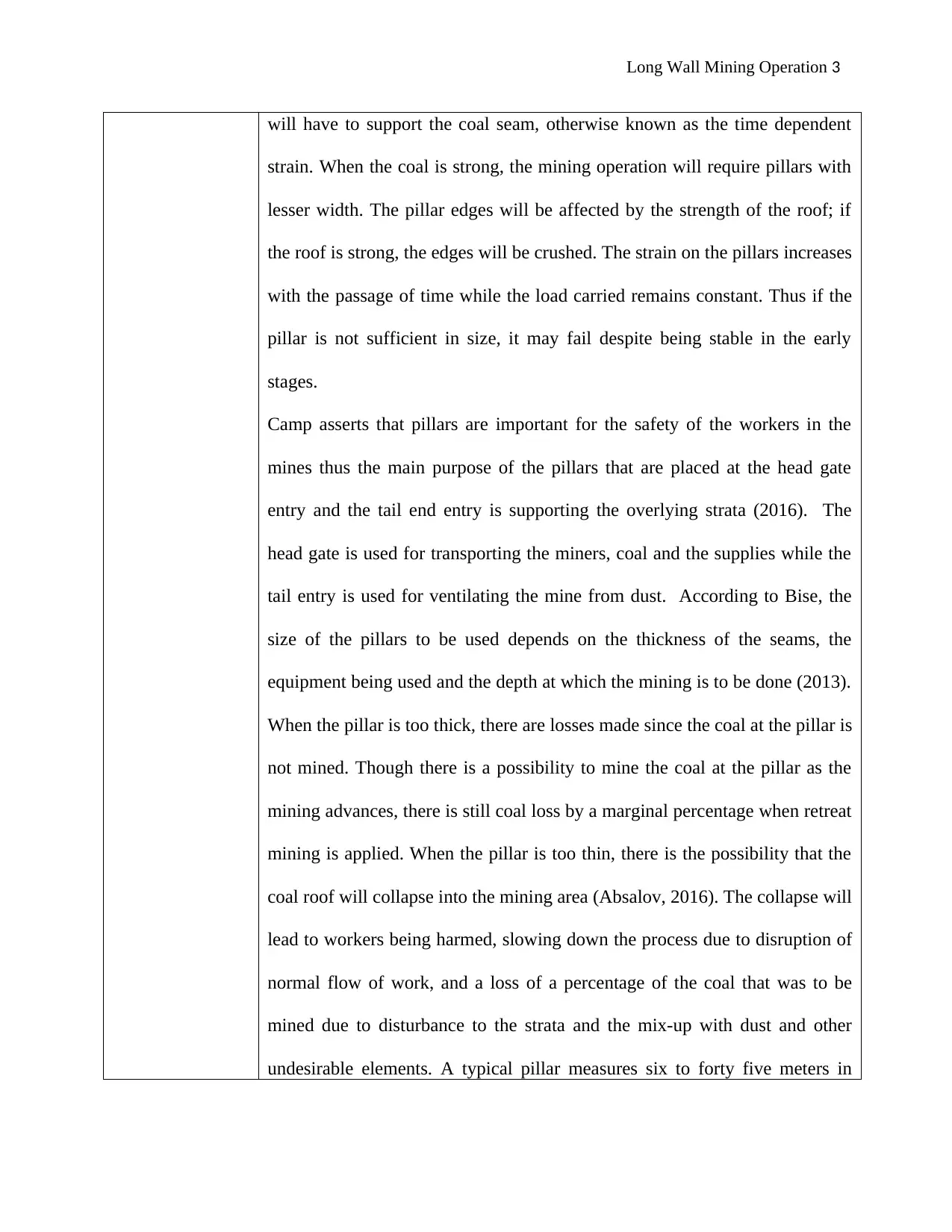
Long Wall Mining Operation 3
will have to support the coal seam, otherwise known as the time dependent
strain. When the coal is strong, the mining operation will require pillars with
lesser width. The pillar edges will be affected by the strength of the roof; if
the roof is strong, the edges will be crushed. The strain on the pillars increases
with the passage of time while the load carried remains constant. Thus if the
pillar is not sufficient in size, it may fail despite being stable in the early
stages.
Camp asserts that pillars are important for the safety of the workers in the
mines thus the main purpose of the pillars that are placed at the head gate
entry and the tail end entry is supporting the overlying strata (2016). The
head gate is used for transporting the miners, coal and the supplies while the
tail entry is used for ventilating the mine from dust. According to Bise, the
size of the pillars to be used depends on the thickness of the seams, the
equipment being used and the depth at which the mining is to be done (2013).
When the pillar is too thick, there are losses made since the coal at the pillar is
not mined. Though there is a possibility to mine the coal at the pillar as the
mining advances, there is still coal loss by a marginal percentage when retreat
mining is applied. When the pillar is too thin, there is the possibility that the
coal roof will collapse into the mining area (Absalov, 2016). The collapse will
lead to workers being harmed, slowing down the process due to disruption of
normal flow of work, and a loss of a percentage of the coal that was to be
mined due to disturbance to the strata and the mix-up with dust and other
undesirable elements. A typical pillar measures six to forty five meters in
will have to support the coal seam, otherwise known as the time dependent
strain. When the coal is strong, the mining operation will require pillars with
lesser width. The pillar edges will be affected by the strength of the roof; if
the roof is strong, the edges will be crushed. The strain on the pillars increases
with the passage of time while the load carried remains constant. Thus if the
pillar is not sufficient in size, it may fail despite being stable in the early
stages.
Camp asserts that pillars are important for the safety of the workers in the
mines thus the main purpose of the pillars that are placed at the head gate
entry and the tail end entry is supporting the overlying strata (2016). The
head gate is used for transporting the miners, coal and the supplies while the
tail entry is used for ventilating the mine from dust. According to Bise, the
size of the pillars to be used depends on the thickness of the seams, the
equipment being used and the depth at which the mining is to be done (2013).
When the pillar is too thick, there are losses made since the coal at the pillar is
not mined. Though there is a possibility to mine the coal at the pillar as the
mining advances, there is still coal loss by a marginal percentage when retreat
mining is applied. When the pillar is too thin, there is the possibility that the
coal roof will collapse into the mining area (Absalov, 2016). The collapse will
lead to workers being harmed, slowing down the process due to disruption of
normal flow of work, and a loss of a percentage of the coal that was to be
mined due to disturbance to the strata and the mix-up with dust and other
undesirable elements. A typical pillar measures six to forty five meters in
⊘ This is a preview!⊘
Do you want full access?
Subscribe today to unlock all pages.

Trusted by 1+ million students worldwide
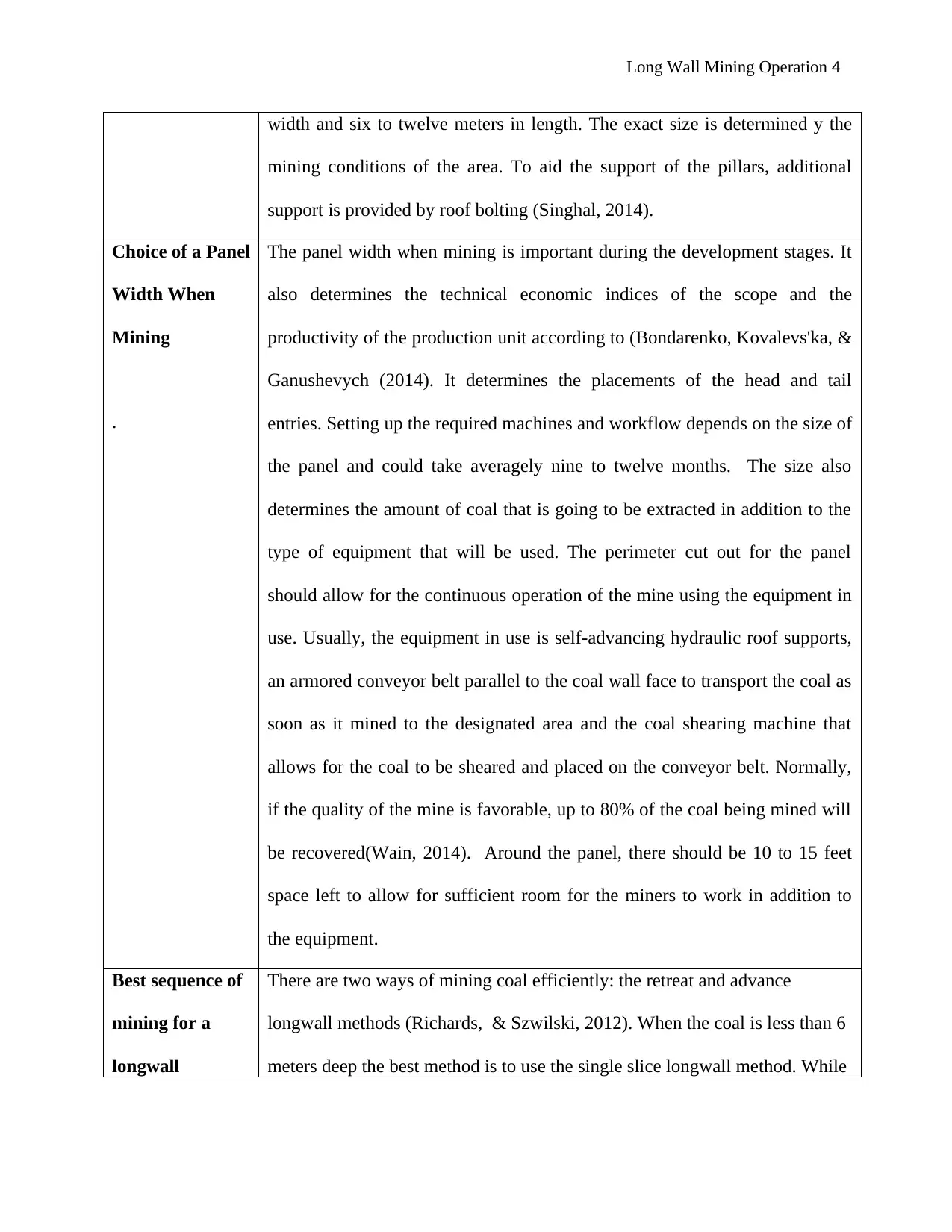
Long Wall Mining Operation 4
width and six to twelve meters in length. The exact size is determined y the
mining conditions of the area. To aid the support of the pillars, additional
support is provided by roof bolting (Singhal, 2014).
Choice of a Panel
Width When
Mining
.
The panel width when mining is important during the development stages. It
also determines the technical economic indices of the scope and the
productivity of the production unit according to (Bondarenko, Kovalevs'ka, &
Ganushevych (2014). It determines the placements of the head and tail
entries. Setting up the required machines and workflow depends on the size of
the panel and could take averagely nine to twelve months. The size also
determines the amount of coal that is going to be extracted in addition to the
type of equipment that will be used. The perimeter cut out for the panel
should allow for the continuous operation of the mine using the equipment in
use. Usually, the equipment in use is self-advancing hydraulic roof supports,
an armored conveyor belt parallel to the coal wall face to transport the coal as
soon as it mined to the designated area and the coal shearing machine that
allows for the coal to be sheared and placed on the conveyor belt. Normally,
if the quality of the mine is favorable, up to 80% of the coal being mined will
be recovered(Wain, 2014). Around the panel, there should be 10 to 15 feet
space left to allow for sufficient room for the miners to work in addition to
the equipment.
Best sequence of
mining for a
longwall
There are two ways of mining coal efficiently: the retreat and advance
longwall methods (Richards, & Szwilski, 2012). When the coal is less than 6
meters deep the best method is to use the single slice longwall method. While
width and six to twelve meters in length. The exact size is determined y the
mining conditions of the area. To aid the support of the pillars, additional
support is provided by roof bolting (Singhal, 2014).
Choice of a Panel
Width When
Mining
.
The panel width when mining is important during the development stages. It
also determines the technical economic indices of the scope and the
productivity of the production unit according to (Bondarenko, Kovalevs'ka, &
Ganushevych (2014). It determines the placements of the head and tail
entries. Setting up the required machines and workflow depends on the size of
the panel and could take averagely nine to twelve months. The size also
determines the amount of coal that is going to be extracted in addition to the
type of equipment that will be used. The perimeter cut out for the panel
should allow for the continuous operation of the mine using the equipment in
use. Usually, the equipment in use is self-advancing hydraulic roof supports,
an armored conveyor belt parallel to the coal wall face to transport the coal as
soon as it mined to the designated area and the coal shearing machine that
allows for the coal to be sheared and placed on the conveyor belt. Normally,
if the quality of the mine is favorable, up to 80% of the coal being mined will
be recovered(Wain, 2014). Around the panel, there should be 10 to 15 feet
space left to allow for sufficient room for the miners to work in addition to
the equipment.
Best sequence of
mining for a
longwall
There are two ways of mining coal efficiently: the retreat and advance
longwall methods (Richards, & Szwilski, 2012). When the coal is less than 6
meters deep the best method is to use the single slice longwall method. While
Paraphrase This Document
Need a fresh take? Get an instant paraphrase of this document with our AI Paraphraser
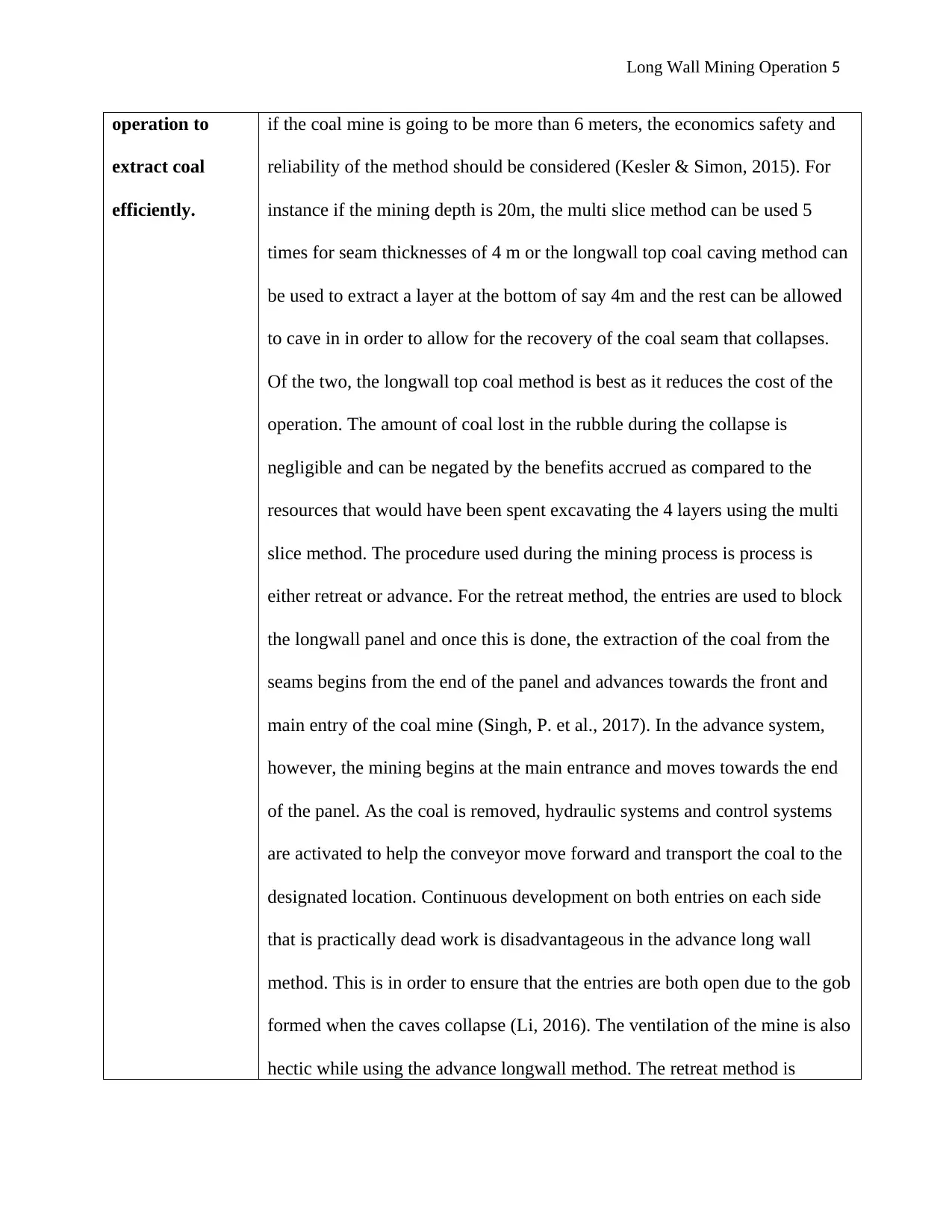
Long Wall Mining Operation 5
operation to
extract coal
efficiently.
if the coal mine is going to be more than 6 meters, the economics safety and
reliability of the method should be considered (Kesler & Simon, 2015). For
instance if the mining depth is 20m, the multi slice method can be used 5
times for seam thicknesses of 4 m or the longwall top coal caving method can
be used to extract a layer at the bottom of say 4m and the rest can be allowed
to cave in in order to allow for the recovery of the coal seam that collapses.
Of the two, the longwall top coal method is best as it reduces the cost of the
operation. The amount of coal lost in the rubble during the collapse is
negligible and can be negated by the benefits accrued as compared to the
resources that would have been spent excavating the 4 layers using the multi
slice method. The procedure used during the mining process is process is
either retreat or advance. For the retreat method, the entries are used to block
the longwall panel and once this is done, the extraction of the coal from the
seams begins from the end of the panel and advances towards the front and
main entry of the coal mine (Singh, P. et al., 2017). In the advance system,
however, the mining begins at the main entrance and moves towards the end
of the panel. As the coal is removed, hydraulic systems and control systems
are activated to help the conveyor move forward and transport the coal to the
designated location. Continuous development on both entries on each side
that is practically dead work is disadvantageous in the advance long wall
method. This is in order to ensure that the entries are both open due to the gob
formed when the caves collapse (Li, 2016). The ventilation of the mine is also
hectic while using the advance longwall method. The retreat method is
operation to
extract coal
efficiently.
if the coal mine is going to be more than 6 meters, the economics safety and
reliability of the method should be considered (Kesler & Simon, 2015). For
instance if the mining depth is 20m, the multi slice method can be used 5
times for seam thicknesses of 4 m or the longwall top coal caving method can
be used to extract a layer at the bottom of say 4m and the rest can be allowed
to cave in in order to allow for the recovery of the coal seam that collapses.
Of the two, the longwall top coal method is best as it reduces the cost of the
operation. The amount of coal lost in the rubble during the collapse is
negligible and can be negated by the benefits accrued as compared to the
resources that would have been spent excavating the 4 layers using the multi
slice method. The procedure used during the mining process is process is
either retreat or advance. For the retreat method, the entries are used to block
the longwall panel and once this is done, the extraction of the coal from the
seams begins from the end of the panel and advances towards the front and
main entry of the coal mine (Singh, P. et al., 2017). In the advance system,
however, the mining begins at the main entrance and moves towards the end
of the panel. As the coal is removed, hydraulic systems and control systems
are activated to help the conveyor move forward and transport the coal to the
designated location. Continuous development on both entries on each side
that is practically dead work is disadvantageous in the advance long wall
method. This is in order to ensure that the entries are both open due to the gob
formed when the caves collapse (Li, 2016). The ventilation of the mine is also
hectic while using the advance longwall method. The retreat method is
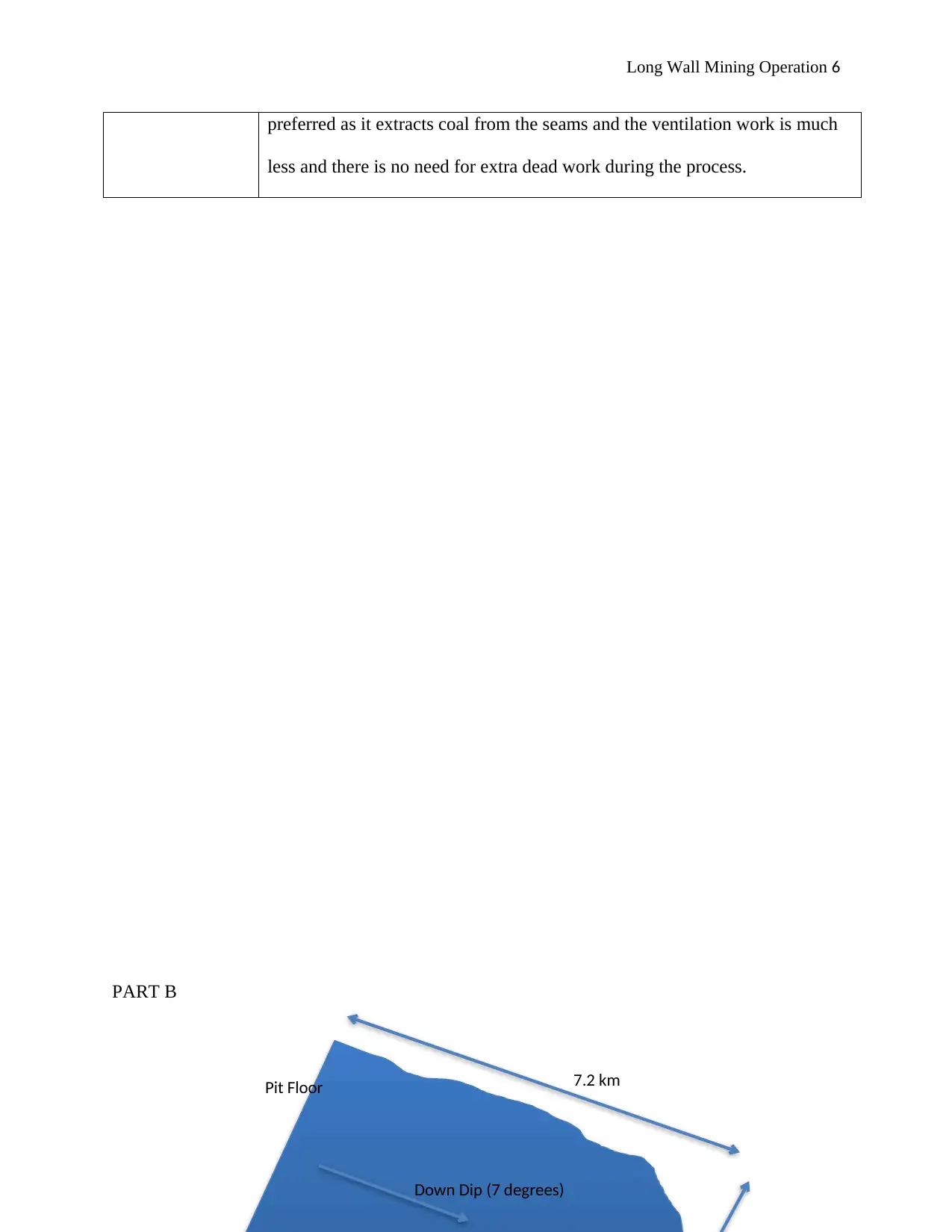
Long Wall Mining Operation 6
preferred as it extracts coal from the seams and the ventilation work is much
less and there is no need for extra dead work during the process.
PART B
7.2 km
Down Dip (7 degrees)
Pit Floor
preferred as it extracts coal from the seams and the ventilation work is much
less and there is no need for extra dead work during the process.
PART B
7.2 km
Down Dip (7 degrees)
Pit Floor
⊘ This is a preview!⊘
Do you want full access?
Subscribe today to unlock all pages.

Trusted by 1+ million students worldwide
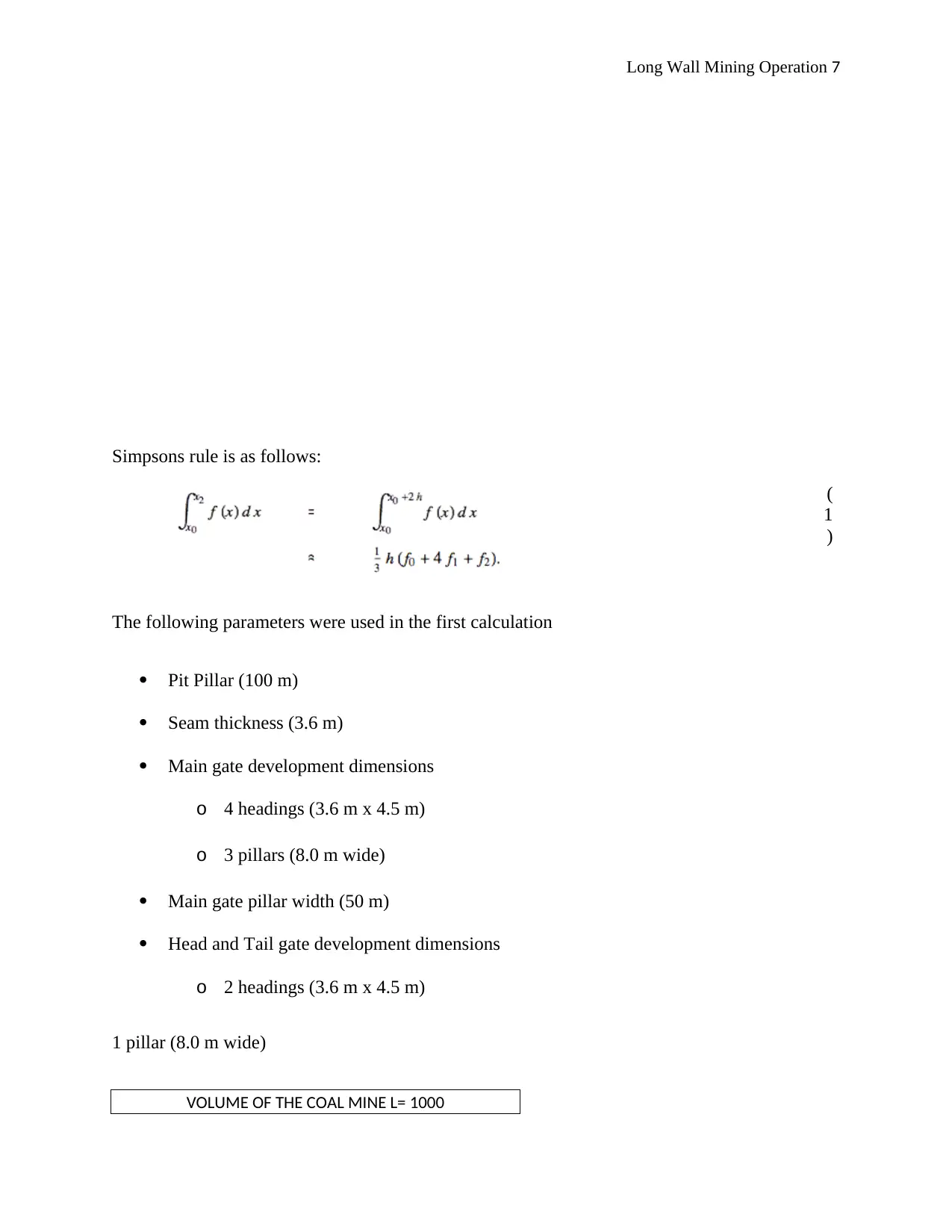
Long Wall Mining Operation 7
Simpsons rule is as follows:
(
1
)
The following parameters were used in the first calculation
Pit Pillar (100 m)
Seam thickness (3.6 m)
Main gate development dimensions
o 4 headings (3.6 m x 4.5 m)
o 3 pillars (8.0 m wide)
Main gate pillar width (50 m)
Head and Tail gate development dimensions
o 2 headings (3.6 m x 4.5 m)
1 pillar (8.0 m wide)
VOLUME OF THE COAL MINE L= 1000
Simpsons rule is as follows:
(
1
)
The following parameters were used in the first calculation
Pit Pillar (100 m)
Seam thickness (3.6 m)
Main gate development dimensions
o 4 headings (3.6 m x 4.5 m)
o 3 pillars (8.0 m wide)
Main gate pillar width (50 m)
Head and Tail gate development dimensions
o 2 headings (3.6 m x 4.5 m)
1 pillar (8.0 m wide)
VOLUME OF THE COAL MINE L= 1000
Paraphrase This Document
Need a fresh take? Get an instant paraphrase of this document with our AI Paraphraser
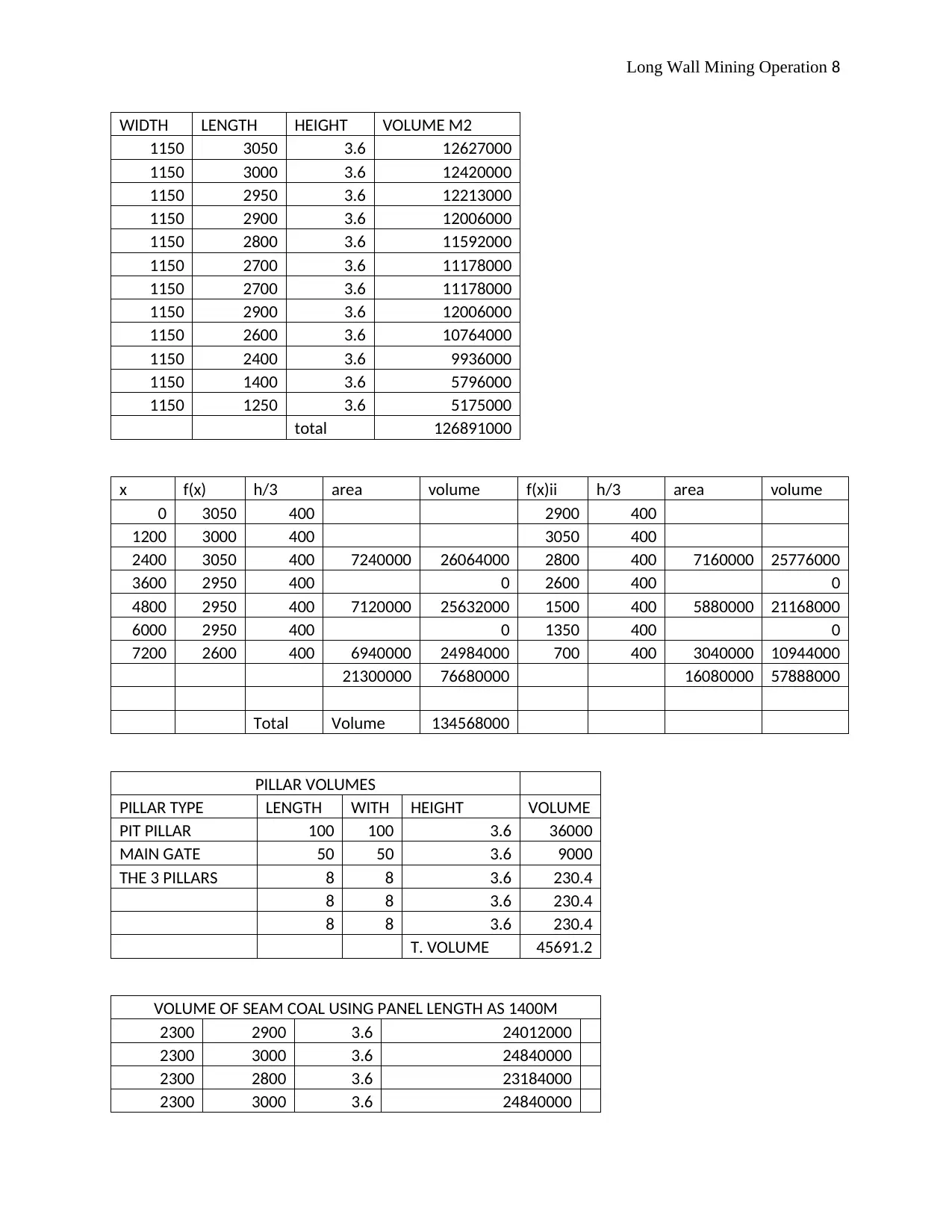
Long Wall Mining Operation 8
WIDTH LENGTH HEIGHT VOLUME M2
1150 3050 3.6 12627000
1150 3000 3.6 12420000
1150 2950 3.6 12213000
1150 2900 3.6 12006000
1150 2800 3.6 11592000
1150 2700 3.6 11178000
1150 2700 3.6 11178000
1150 2900 3.6 12006000
1150 2600 3.6 10764000
1150 2400 3.6 9936000
1150 1400 3.6 5796000
1150 1250 3.6 5175000
total 126891000
x f(x) h/3 area volume f(x)ii h/3 area volume
0 3050 400 2900 400
1200 3000 400 3050 400
2400 3050 400 7240000 26064000 2800 400 7160000 25776000
3600 2950 400 0 2600 400 0
4800 2950 400 7120000 25632000 1500 400 5880000 21168000
6000 2950 400 0 1350 400 0
7200 2600 400 6940000 24984000 700 400 3040000 10944000
21300000 76680000 16080000 57888000
Total Volume 134568000
PILLAR VOLUMES
PILLAR TYPE LENGTH WITH HEIGHT VOLUME
PIT PILLAR 100 100 3.6 36000
MAIN GATE 50 50 3.6 9000
THE 3 PILLARS 8 8 3.6 230.4
8 8 3.6 230.4
8 8 3.6 230.4
T. VOLUME 45691.2
VOLUME OF SEAM COAL USING PANEL LENGTH AS 1400M
2300 2900 3.6 24012000
2300 3000 3.6 24840000
2300 2800 3.6 23184000
2300 3000 3.6 24840000
WIDTH LENGTH HEIGHT VOLUME M2
1150 3050 3.6 12627000
1150 3000 3.6 12420000
1150 2950 3.6 12213000
1150 2900 3.6 12006000
1150 2800 3.6 11592000
1150 2700 3.6 11178000
1150 2700 3.6 11178000
1150 2900 3.6 12006000
1150 2600 3.6 10764000
1150 2400 3.6 9936000
1150 1400 3.6 5796000
1150 1250 3.6 5175000
total 126891000
x f(x) h/3 area volume f(x)ii h/3 area volume
0 3050 400 2900 400
1200 3000 400 3050 400
2400 3050 400 7240000 26064000 2800 400 7160000 25776000
3600 2950 400 0 2600 400 0
4800 2950 400 7120000 25632000 1500 400 5880000 21168000
6000 2950 400 0 1350 400 0
7200 2600 400 6940000 24984000 700 400 3040000 10944000
21300000 76680000 16080000 57888000
Total Volume 134568000
PILLAR VOLUMES
PILLAR TYPE LENGTH WITH HEIGHT VOLUME
PIT PILLAR 100 100 3.6 36000
MAIN GATE 50 50 3.6 9000
THE 3 PILLARS 8 8 3.6 230.4
8 8 3.6 230.4
8 8 3.6 230.4
T. VOLUME 45691.2
VOLUME OF SEAM COAL USING PANEL LENGTH AS 1400M
2300 2900 3.6 24012000
2300 3000 3.6 24840000
2300 2800 3.6 23184000
2300 3000 3.6 24840000
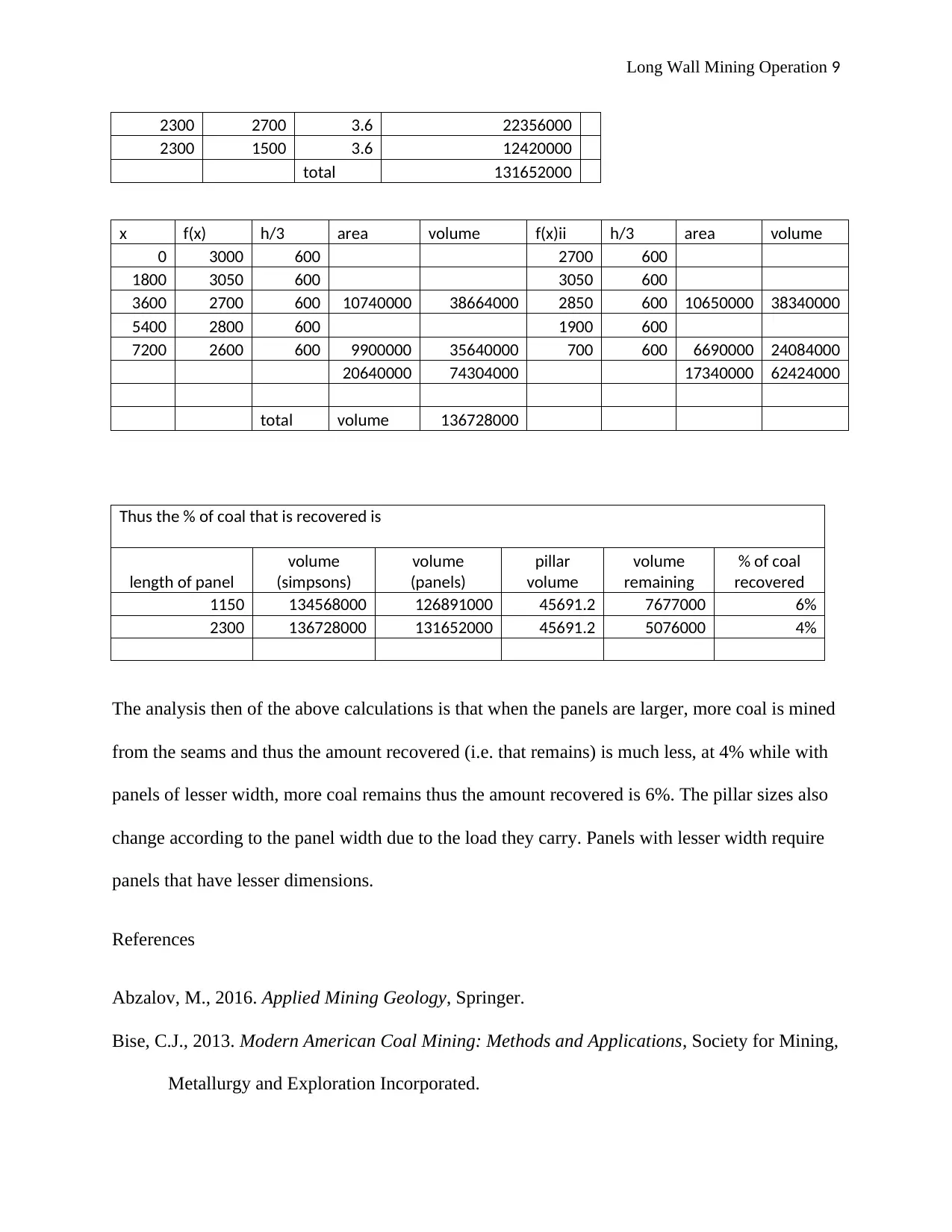
Long Wall Mining Operation 9
2300 2700 3.6 22356000
2300 1500 3.6 12420000
total 131652000
x f(x) h/3 area volume f(x)ii h/3 area volume
0 3000 600 2700 600
1800 3050 600 3050 600
3600 2700 600 10740000 38664000 2850 600 10650000 38340000
5400 2800 600 1900 600
7200 2600 600 9900000 35640000 700 600 6690000 24084000
20640000 74304000 17340000 62424000
total volume 136728000
Thus the % of coal that is recovered is
length of panel
volume
(simpsons)
volume
(panels)
pillar
volume
volume
remaining
% of coal
recovered
1150 134568000 126891000 45691.2 7677000 6%
2300 136728000 131652000 45691.2 5076000 4%
The analysis then of the above calculations is that when the panels are larger, more coal is mined
from the seams and thus the amount recovered (i.e. that remains) is much less, at 4% while with
panels of lesser width, more coal remains thus the amount recovered is 6%. The pillar sizes also
change according to the panel width due to the load they carry. Panels with lesser width require
panels that have lesser dimensions.
References
Abzalov, M., 2016. Applied Mining Geology, Springer.
Bise, C.J., 2013. Modern American Coal Mining: Methods and Applications, Society for Mining,
Metallurgy and Exploration Incorporated.
2300 2700 3.6 22356000
2300 1500 3.6 12420000
total 131652000
x f(x) h/3 area volume f(x)ii h/3 area volume
0 3000 600 2700 600
1800 3050 600 3050 600
3600 2700 600 10740000 38664000 2850 600 10650000 38340000
5400 2800 600 1900 600
7200 2600 600 9900000 35640000 700 600 6690000 24084000
20640000 74304000 17340000 62424000
total volume 136728000
Thus the % of coal that is recovered is
length of panel
volume
(simpsons)
volume
(panels)
pillar
volume
volume
remaining
% of coal
recovered
1150 134568000 126891000 45691.2 7677000 6%
2300 136728000 131652000 45691.2 5076000 4%
The analysis then of the above calculations is that when the panels are larger, more coal is mined
from the seams and thus the amount recovered (i.e. that remains) is much less, at 4% while with
panels of lesser width, more coal remains thus the amount recovered is 6%. The pillar sizes also
change according to the panel width due to the load they carry. Panels with lesser width require
panels that have lesser dimensions.
References
Abzalov, M., 2016. Applied Mining Geology, Springer.
Bise, C.J., 2013. Modern American Coal Mining: Methods and Applications, Society for Mining,
Metallurgy and Exploration Incorporated.
⊘ This is a preview!⊘
Do you want full access?
Subscribe today to unlock all pages.

Trusted by 1+ million students worldwide
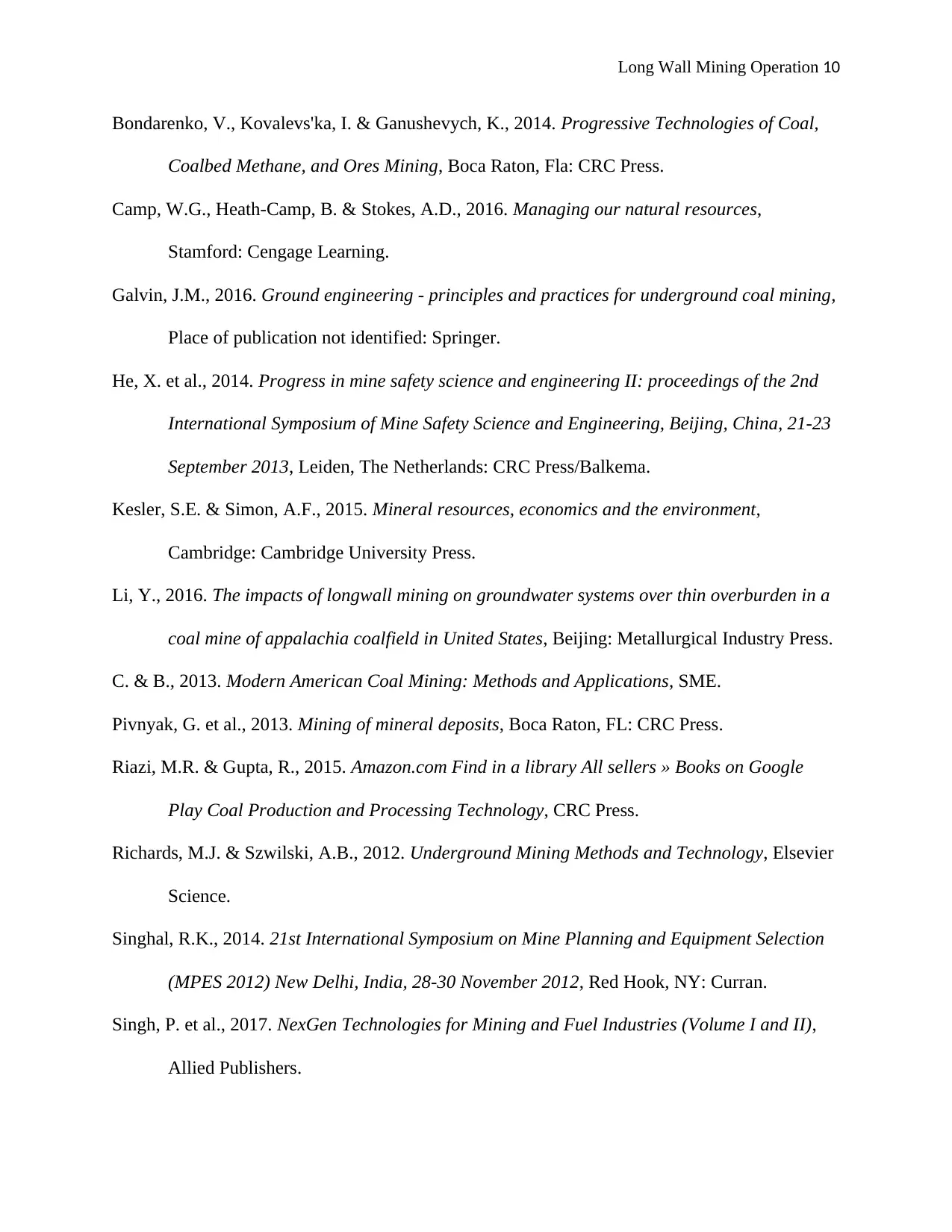
Long Wall Mining Operation 10
Bondarenko, V., Kovalevs'ka, I. & Ganushevych, K., 2014. Progressive Technologies of Coal,
Coalbed Methane, and Ores Mining, Boca Raton, Fla: CRC Press.
Camp, W.G., Heath-Camp, B. & Stokes, A.D., 2016. Managing our natural resources,
Stamford: Cengage Learning.
Galvin, J.M., 2016. Ground engineering - principles and practices for underground coal mining,
Place of publication not identified: Springer.
He, X. et al., 2014. Progress in mine safety science and engineering II: proceedings of the 2nd
International Symposium of Mine Safety Science and Engineering, Beijing, China, 21-23
September 2013, Leiden, The Netherlands: CRC Press/Balkema.
Kesler, S.E. & Simon, A.F., 2015. Mineral resources, economics and the environment,
Cambridge: Cambridge University Press.
Li, Y., 2016. The impacts of longwall mining on groundwater systems over thin overburden in a
coal mine of appalachia coalfield in United States, Beijing: Metallurgical Industry Press.
C. & B., 2013. Modern American Coal Mining: Methods and Applications, SME.
Pivnyak, G. et al., 2013. Mining of mineral deposits, Boca Raton, FL: CRC Press.
Riazi, M.R. & Gupta, R., 2015. Amazon.com Find in a library All sellers » Books on Google
Play Coal Production and Processing Technology, CRC Press.
Richards, M.J. & Szwilski, A.B., 2012. Underground Mining Methods and Technology, Elsevier
Science.
Singhal, R.K., 2014. 21st International Symposium on Mine Planning and Equipment Selection
(MPES 2012) New Delhi, India, 28-30 November 2012, Red Hook, NY: Curran.
Singh, P. et al., 2017. NexGen Technologies for Mining and Fuel Industries (Volume I and II),
Allied Publishers.
Bondarenko, V., Kovalevs'ka, I. & Ganushevych, K., 2014. Progressive Technologies of Coal,
Coalbed Methane, and Ores Mining, Boca Raton, Fla: CRC Press.
Camp, W.G., Heath-Camp, B. & Stokes, A.D., 2016. Managing our natural resources,
Stamford: Cengage Learning.
Galvin, J.M., 2016. Ground engineering - principles and practices for underground coal mining,
Place of publication not identified: Springer.
He, X. et al., 2014. Progress in mine safety science and engineering II: proceedings of the 2nd
International Symposium of Mine Safety Science and Engineering, Beijing, China, 21-23
September 2013, Leiden, The Netherlands: CRC Press/Balkema.
Kesler, S.E. & Simon, A.F., 2015. Mineral resources, economics and the environment,
Cambridge: Cambridge University Press.
Li, Y., 2016. The impacts of longwall mining on groundwater systems over thin overburden in a
coal mine of appalachia coalfield in United States, Beijing: Metallurgical Industry Press.
C. & B., 2013. Modern American Coal Mining: Methods and Applications, SME.
Pivnyak, G. et al., 2013. Mining of mineral deposits, Boca Raton, FL: CRC Press.
Riazi, M.R. & Gupta, R., 2015. Amazon.com Find in a library All sellers » Books on Google
Play Coal Production and Processing Technology, CRC Press.
Richards, M.J. & Szwilski, A.B., 2012. Underground Mining Methods and Technology, Elsevier
Science.
Singhal, R.K., 2014. 21st International Symposium on Mine Planning and Equipment Selection
(MPES 2012) New Delhi, India, 28-30 November 2012, Red Hook, NY: Curran.
Singh, P. et al., 2017. NexGen Technologies for Mining and Fuel Industries (Volume I and II),
Allied Publishers.
Paraphrase This Document
Need a fresh take? Get an instant paraphrase of this document with our AI Paraphraser

Long Wall Mining Operation 11
Wain, K., 2014. The Coalmining Industry: Of Barnsley, Rotherham And Worksop, Amberley
Publishing Limited.
Woodruff, S.D., 2016. Methods of Working Coal and Metal Mines:Planning and Operations,
Elsevier.
Wain, K., 2014. The Coalmining Industry: Of Barnsley, Rotherham And Worksop, Amberley
Publishing Limited.
Woodruff, S.D., 2016. Methods of Working Coal and Metal Mines:Planning and Operations,
Elsevier.
1 out of 11
Related Documents
Your All-in-One AI-Powered Toolkit for Academic Success.
+13062052269
info@desklib.com
Available 24*7 on WhatsApp / Email
![[object Object]](/_next/static/media/star-bottom.7253800d.svg)
Unlock your academic potential
Copyright © 2020–2025 A2Z Services. All Rights Reserved. Developed and managed by ZUCOL.



